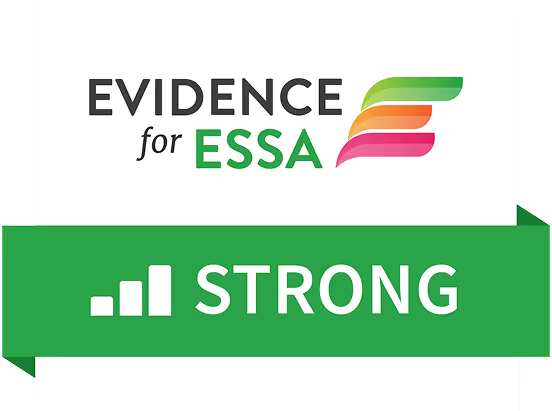Independent Evaluations of Post-Pandemic Recovery
Independent Evaluations of Post-Pandemic Recovery
Independent Evaluations of Post-Pandemic Recovery
Independent Evaluations of Post-Pandemic Recovery

Zearn Math has received a “Strong” (Tier 1) rating from Evidence for ESSA — the highest designation from a nationally recognized, independent clearinghouse that evaluates education research to help schools, districts, and states select evidence-based programs. This top rating confirms that Zearn Math meets the rigorous evidence standards outlined in the Every Student Succeeds Act (ESSA).
Zearn Math has received a “Strong” (Tier 1) rating from Evidence for ESSA — the highest designation from a nationally recognized, independent clearinghouse that evaluates education research to help schools, districts, and states select evidence-based programs. This top rating confirms that Zearn Math meets the rigorous evidence standards outlined in the Every Student Succeeds Act (ESSA).
Zearn Math has received a “Strong” (Tier 1) rating from Evidence for ESSA — the highest designation from a nationally recognized, independent clearinghouse that evaluates education research to help schools, districts, and states select evidence-based programs. This top rating confirms that Zearn Math meets the rigorous evidence standards outlined in the Every Student Succeeds Act (ESSA).
A large-scale randomized controlled trial, conducted across 10,000 students in grades 3–5 in 64 schools in a large urban Texas district, found causal evidence of positive, statistically significant impacts of Zearn on student math achievement, as measured by the nationally normed NWEA MAP Growth assessment.
A large-scale randomized controlled trial, conducted across 10,000 students in grades 3–5 in 64 schools in a large urban Texas district, found causal evidence of positive, statistically significant impacts of Zearn on student math achievement, as measured by the nationally normed NWEA MAP Growth assessment.
A large-scale randomized controlled trial, conducted across 10,000 students in grades 3–5 in 64 schools in a large urban Texas district, found causal evidence of positive, statistically significant impacts of Zearn on student math achievement, as measured by the nationally normed NWEA MAP Growth assessment.
A large-scale randomized controlled trial, conducted across 10,000 students in grades 3–5 in 64 schools in a large urban Texas district, found causal evidence of positive, statistically significant impacts of Zearn on student math achievement, as measured by the nationally normed NWEA MAP Growth assessment.
A large-scale randomized controlled trial, conducted across 10,000 students in grades 3–5 in 64 schools in a large urban Texas district, found causal evidence of positive, statistically significant impacts of Zearn on student math achievement, as measured by the nationally normed NWEA MAP Growth assessment.
A quasi-experimental study (2023–2024) of over 7,000 students in grades 4–8 in three suburban and rural Louisiana districts found districts using Zearn with dedicated implementation support (e.g, school coaching, educator training, usage monitoring) significantly outperformed peers on the state math assessment.
A quasi-experimental study (2023–2024) of over 7,000 students in grades 4–8 in three suburban and rural Louisiana districts found districts using Zearn with dedicated implementation support (e.g, school coaching, educator training, usage monitoring) significantly outperformed peers on the state math assessment.
A quasi-experimental study (2023–2024) of over 7,000 students in grades 4–8 in three suburban and rural Louisiana districts found districts using Zearn with dedicated implementation support (e.g, school coaching, educator training, usage monitoring) significantly outperformed peers on the state math assessment.
A quasi-experimental study (2023–2024) of over 7,000 students in grades 4–8 in three suburban and rural Louisiana districts found districts using Zearn with dedicated implementation support (e.g, school coaching, educator training, usage monitoring) significantly outperformed peers on the state math assessment.
A quasi-experimental study (2023–2024) of over 7,000 students in grades 4–8 in three suburban and rural Louisiana districts found districts using Zearn with dedicated implementation support (e.g, school coaching, educator training, usage monitoring) significantly outperformed peers on the state math assessment.
Evidence of Impact from Consistent Zearn Usage
Evidence of Impact from Consistent Zearn Usage
Evidence of Impact from Consistent Zearn Usage
Evidence of Impact from Consistent Zearn Usage
Consistent Zearn usage significantly increases math scores across usage levels

Fidelity Zearn usage results in 2.5 times the growth in math scores

Two-year study finds consistent Zearn usage increase math scores

Students who use Zearn with fidelity outscore matched peers across all starting levels of math achievement

Advancing Math Teaching and Learning
Advancing Math Teaching and Learning
Advancing Math Teaching and Learning
Advancing Math Teaching and Learning
Lorem ipsum dolor sit amet, consectetur adipiscing elit, sed do eiusmod tempor incididunt ut labore et dolore magna aliqua.
Lorem ipsum dolor sit amet, consectetur adipiscing elit, sed do eiusmod tempor incididunt ut labore et dolore magna aliqua.
Lorem ipsum dolor sit amet, consectetur adipiscing elit, sed do eiusmod tempor incididunt ut labore et dolore magna aliqua.
Opportunity Insights
Researchers from Harvard and Brown Universities use Zearn data to provide real-time visibility into the pandemic's impact on math learning
Catching Up and Moving Forward
Statistically significant quasi-experimental evidence supporting learning acceleration to support student progress in math
Behavior Change for Good
In a national megastudy involving 3M students, researchers find personalized email nudges to teachers boost elementary math progress